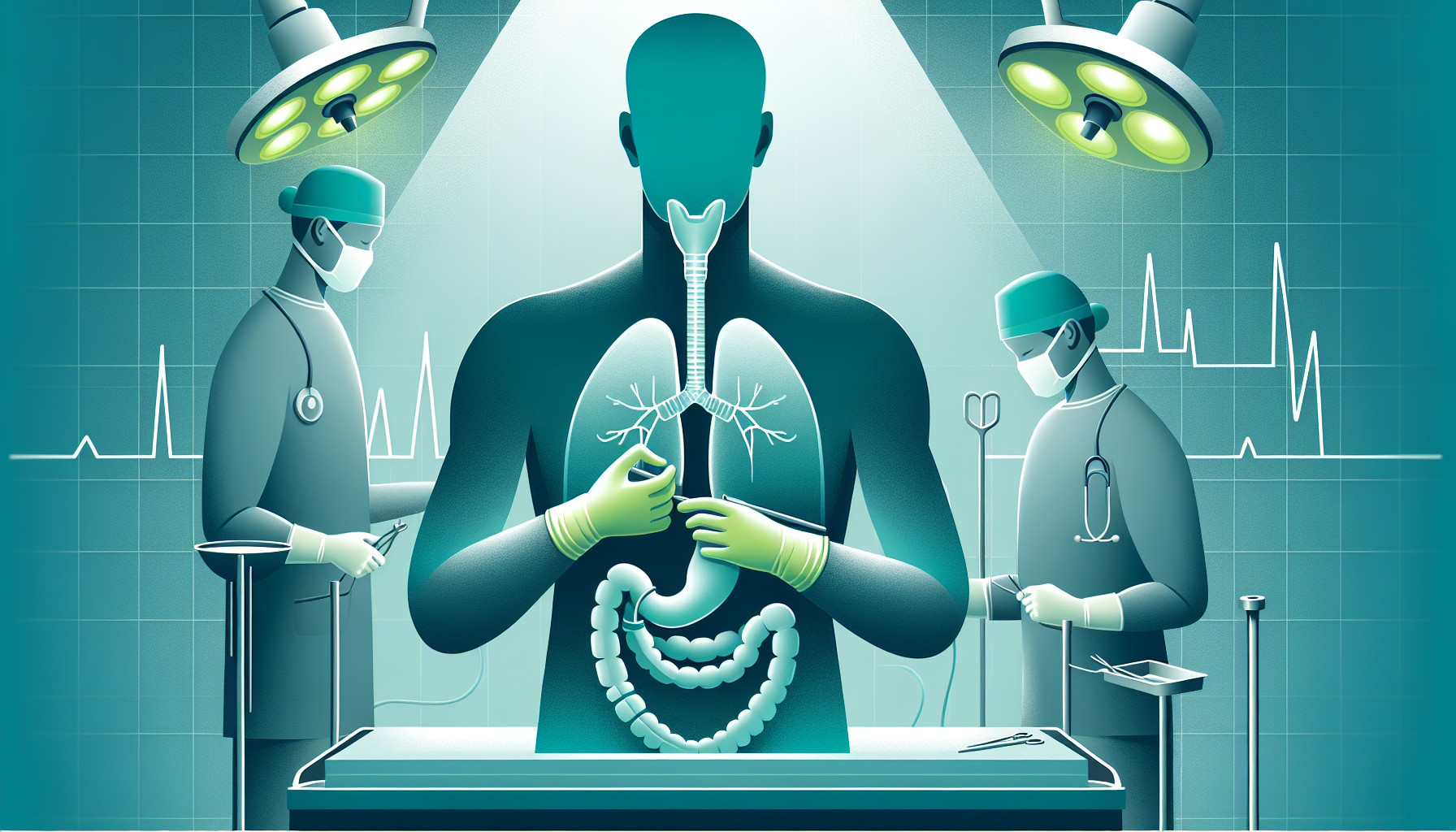Our Summary
This research paper looks at the outcomes of two different types of esophagus removal surgeries, known as esophagectomies, in patients who have previously undergone a total removal of their voice box and throat (called a total pharyngolaryngectomy or TPL). The researchers looked back at the cases of 36 such patients.
The two types of surgeries are the McKeown and Ivor-Lewis esophagectomies. In the patient group, 12 had the McKeown procedure and 24 had the Ivor-Lewis. The researchers found that the McKeown procedure was used more often for tumors located above the heart (supracarinal tumors).
In terms of complications after surgery, the McKeown group had a higher rate of pneumonia and leakage from the surgical connection (anastomotic leakage). However, they didn’t see any issues with tissue death (necrosis) in the windpipe or leftover parts of the esophagus.
When looking at survival rates and the chance of the cancer coming back, there was no difference between the two groups.
The researchers concluded that, for patients who have previously had a TPL, if it is possible and wouldn’t affect the cancer treatment, the Ivor-Lewis esophagectomy is a better choice because it has fewer complications after surgery.
FAQs
- What are the two types of esophagectomy procedures discussed in this article?
- Between the McKeown and Ivor-Lewis esophagectomies, which one had higher incidences of postoperative complications?
- Is there a difference in survival rates between patients who underwent McKeown and Ivor-Lewis esophagectomies?
Doctor’s Tip
A helpful tip a doctor might tell a patient about esophagectomy is to carefully follow all postoperative care instructions to reduce the risk of complications such as pneumonia and anastomotic leakage. It is also important to communicate any concerns or symptoms to your healthcare provider promptly.
Suitable For
Patients with a history of total pharyngolaryngectomy who are recommended for esophagectomy typically have supracarinal tumors and may have a history of radiation therapy. The choice between total esophagectomy with cervical anastomosis (McKeown) and subtotal esophagectomy with intrathoracic anastomosis (Ivor-Lewis) will depend on the specific characteristics of the patient and the tumor. In this study, Ivor-Lewis esophagectomy was found to be preferable over McKeown esophagectomy for avoiding postoperative complications in patients with a history of TPL. Overall and recurrence-free survival rates were comparable between the two procedures.
Timeline
Before esophagectomy:
- Patient is diagnosed with esophageal cancer.
- Patient undergoes preoperative evaluations and tests to determine candidacy for surgery.
- Patient may undergo neoadjuvant therapy such as chemotherapy and/or radiation.
- Patient undergoes informed consent process and discussion with surgical team.
After esophagectomy:
- Patient undergoes the chosen esophagectomy procedure (McKeown or Ivor-Lewis).
- Patient is closely monitored in the postoperative period for complications such as pneumonia and anastomotic leakage.
- Patient may require additional treatments or interventions based on postoperative course.
- Patient undergoes follow-up appointments and surveillance for recurrence.
- Patient’s overall and recurrence-free survival rates are monitored and compared to determine long-term outcomes.
What to Ask Your Doctor
Some questions a patient should ask their doctor about esophagectomy include:
- What are the potential risks and complications associated with esophagectomy, especially for patients with a history of total pharyngolaryngectomy?
- What is the difference between total esophagectomy with cervical anastomosis (McKeown) and subtotal esophagectomy with intrathoracic anastomosis (Ivor-Lewis), and which procedure is recommended for my specific case?
- How will the choice of esophagectomy procedure impact my postoperative recovery and quality of life?
- What is the expected timeline for recovery after esophagectomy, and what can I do to help facilitate a smooth recovery process?
- What follow-up care will be necessary after the surgery, and what signs or symptoms should I watch out for that may indicate a complication?
- How will esophagectomy impact my ability to eat and swallow, and what dietary changes or modifications may be necessary?
- What is the long-term outlook for patients who undergo esophagectomy, particularly for those with a history of total pharyngolaryngectomy?
- Are there any alternative treatment options or less invasive procedures that may be suitable for my condition?
- What experience does the surgical team have in performing esophagectomies for patients with a history of total pharyngolaryngectomy, and what is their success rate with these procedures?
- Are there any additional resources or support services available for patients undergoing esophagectomy, particularly for those with unique medical histories or challenges?
Reference
Authors: Kuriyama K, Okamura A, Kanie Y, Maruyama S, Sakamoto K, Kanamori J, Imamura Y, Watanabe M. Journal: World J Surg. 2023 Oct;47(10):2479-2487. doi: 10.1007/s00268-023-07115-0. Epub 2023 Jul 11. PMID: 37432423
